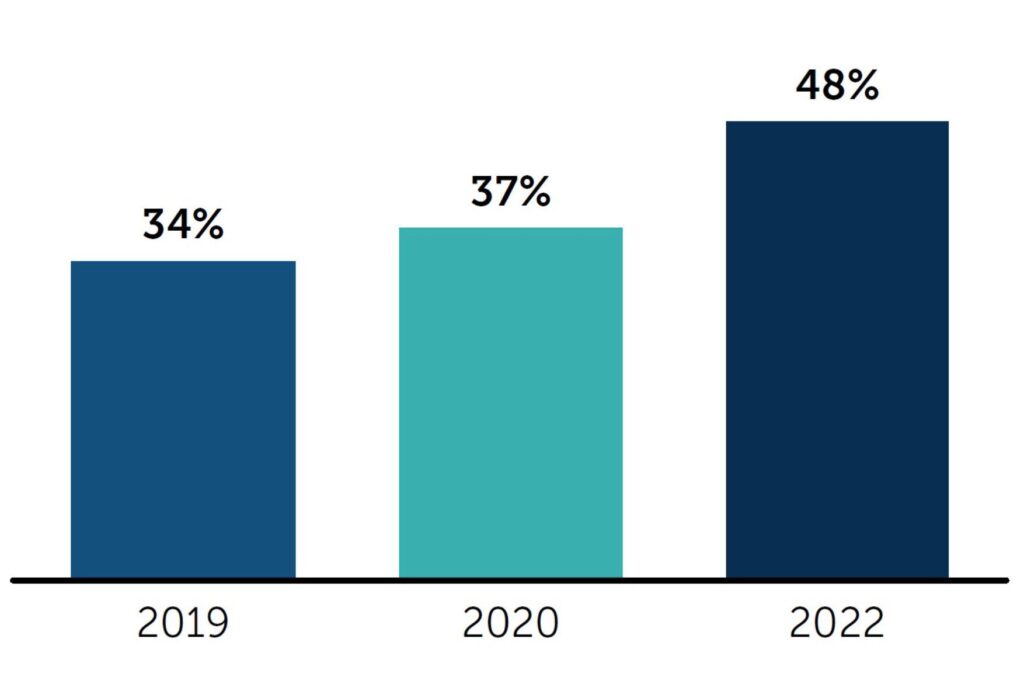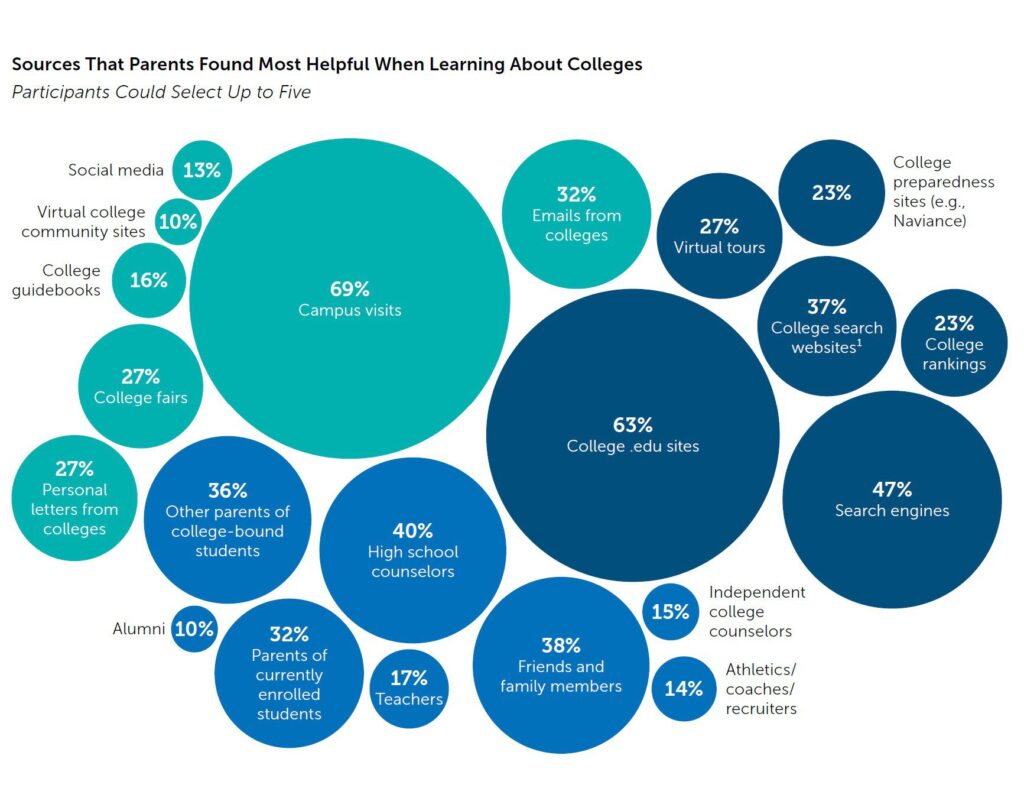Parent involvement in recruitment has increased-here's what that means for your enrollment strategy
October 4, 2022, By Michael Koppenheffer, Vice President, Enroll360 Marketing, Analytics and AI Strategy
As I’ve helped my daughters sift through emails and mailers from colleges to decide which schools will make their short lists, we’ve agreed that the college-selection process gets overwhelming. It’s no wonder that high school students are increasingly reliant on parents for help with their college search.
EAB’s K-12 research has shown that today’s parents are fundamentally different from their predecessors in three important ways: they’re more anxious, less trusting, and more transactional. As parents become more hands-on, many enrollment leaders are unsure how to effectively reach and involve them in the recruitment process.
The rise of intensive parenting
To better understand these issues, we surveyed over 2,000 parents and guardians about their perceptions and preferences related to their children’s college search and decision process. I want to share three of the most important lessons from the research with you here.
Insight 1: Parents want direct communication from colleges
Our research shows that parents are now much more involved in the recruiting process than they used to be-and often more involved than colleges have prepared for. While 75% of parents who responded to our 2022 survey indicated that they want direct communication from schools during the college-search process, many schools have yet to introduce a dedicated parent marketing campaign. As students spent more time around their parents during the pandemic, rather than among their peers, their parents gained more influence on their decision-making. While this boost may level off in the coming years, having a dedicated parent communication plan in place can help you prepare for other unexpected gains in parental influence.
Percentage of students naming parents or guardians in their top five sources

Direct parent marketing, ideally starting early in their children’s high school years, can help you reach parents and retain their interest. Additionally, finding opportunities to communicate directly with parents about the application process, cost of attendance, and student happiness can help make parents your ally-a move that will benefit you in the long run.
Students are...
50%
more likely to apply if their parents have responded to an EAB marketing campaign.The tricky thing about marketing to parents is that it isn’t as easy as turning on a drip campaign and waiting for them to come to you. Communicating with parents effectively requires a robust strategy for sourcing names, which can include asking students for parent contact information and using consumer analytics to identify parents, as EAB does. In addition, parents have distinct interests and preferences in terms of their communications from colleges, just as their children do. Another factor to consider in parent communication is demographics. Though our research shows that underserved student groups don’t rely on parents as much as others, their parents still really want to be involved.
Engage Families and Enroll Your Next Class with Enroll360
Insight 2: Parents are highly concerned—and often uncertain—about college cost and value
As parents lead their children through the college-search process, they are understandably anxious about affordability. When we asked parents what they care about in the college search, cost came in first, ranking slightly above even their children’s happiness. And cost concerns impact not only which college a student will choose, but also whether they’ll attend any college at all.
Today’s parents are most likely to use self-service tools to independently research and compare college costs. While that information is (usually) accessible from the web, it doesn’t typically address parents’ core concerns about cost of attendance, additional fees associated with attendance, and the actual value their children will gain from your institution.
Affordability remains a major concern
1 in 3 parents is concerned that they won’t be able to afford any college, with even higher rates among Black and Hispanic/Latinx families.
Our research shows that almost half of parents think of college in terms of sticker price rather than net cost, and almost a quarter of parents don’t know the maximum amount they’d be willing to pay for a college education. The most uncertain of these groups are lower-income families who will need more nurturing and access to tools and programs to help them understand their out-of-pocket commitments.
To ease parental concerns about cost and value, start by showing parents why a college degree is worth it and update web assets to make cost and value information easily accessible. Provide materials in additional languages, where applicable, so that families don’t have to wait for a translator to learn more. Web updates may seem daunting, but if you focus in your most impactful webpages, it will go a long way towards improved communication.
EAB’S Website Design and Development Team Helps Colleges Communicate Value to Prospects
You should also reassure families that their children will be safe and welcomed on your campus through special initiatives like fly-in programs. These experiences are memorable for students and their families and give parents of first-generation students in particular a clearer understanding of your college environment.
Insight 3: Parents are active participants across many communication channels
Though direct mail remains a common way to reach students and their families, it is certainly not the only effective medium for outreach. Today’s parents are extremely connected and increasingly available; though not usually recognized as digital natives, Gen X is surprisingly on their devices over 5 hours a day. With that in mind, where are parents likely to find your school?

As this diagram shows, parents rely on a mix of sources to learn about colleges. Participating in a variety of newer and traditional channels gives you the opportunity to maximize your reach. While self-service resources like websites and search engines are a top source regardless of family race or ethnicity, our research reveals that parents of White and Asian students find those channels to be most helpful. Parents of Hispanic/Latinx and Black students, however, prefer direct communications from colleges and high school counselors versus self-service tools.
Cohesive marketing and strong branding across channels make it easier for parents to remember your school. As parents browse your website, receive your marketing emails, check their physical mailboxes, and quiz their students’ counselors, each touchpoint builds their affinity for your school.
How colleges can help
As you craft your enrollment marketing materials to reach the next wave of students, consider making a dedicated plan for parent communications. Parents are helping their children navigate one of the biggest (and likely most expensive) decisions of their lives, and they appreciate schools who readily supply them with information. Influencing this group requires strong branding, thorough cost and value materials, and university presence across a wide array of channels.
As a parent involved in helping my children find collegiate satisfaction and success, I appreciate the schools that have actively included me in the college-search process and worked to address my top concerns around cost, value, and belonging. When schools get this communication right, it’s a huge win for parents and students alike. And in an environment where every potential student matters, parents might just be the missing link in your enrollment strategy.

More Blogs

The 2026 .edu accessibility mandate is coming—is your site content ready?

The balancing act: How the right mix of branded and non-branded keywords shapes higher ed SEO

Struggling to attract graduate students? Here are four ways to fix it
Great to see you today! What can I do for you?